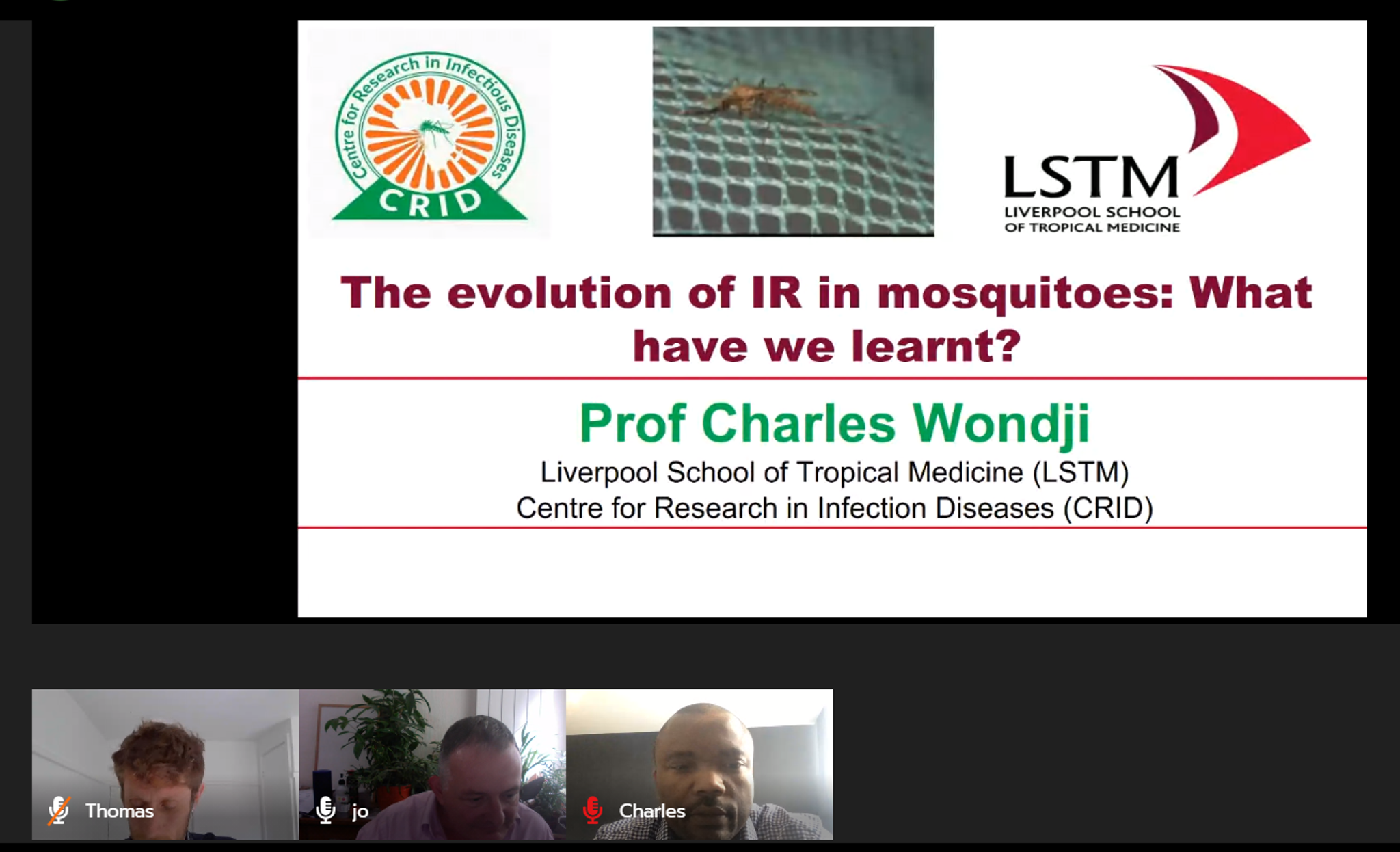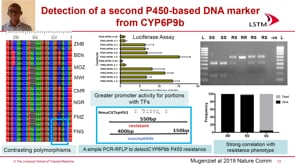7th PAMCA (and 1st Virtual) Conference and Exhibition – 2021: Day 3
Wednesday, 22nd September 2021
Published: 20/09/2021
This report is brought to you by the MESA Correspondents Stella Riunguh, Amelie Wamba Ndongmo Regine, Eggrey Aisha Kambewa, Mauro Pazmino Betancourth, Udoka Chukwubuofu Nwangwu, Thoan Ho Dac, Faith Hungwe, and Jackson Nyarko. Senior editorial support has been facilitated by Charles Quaye
THEMES: THEMES: Vector Control
MESA Correspondents bring you cutting-edge coverage from the 1st Virtual and 7th PAMCA Conference & Exhibition 2021
Day 3: Wednesday, 22nd September 2021
Plenary Session 3: Global health and the emerging challenges of arthropod-borne diseases in Africa
Florence Fouque (Institute Pasteur, France) started her presentation by introducing the concept of global health as population-based, with a focus on the most vulnerable, prevention-oriented, multidisciplinary and multisectorial (Koplan et al. 2009). Fouque summarized the overall challenges with arthropod-borne diseases, such as malaria, to be linked to the vector, the host and the environment. She also mentioned the challenges with arboviral borne diseases in global health including the distribution and adaptability of the vectors, rapidity of spread of the disease and preparedness to unpredictable emerging diseases laying a great emphasis on poverty. Next, she highlighted the challenges due to population-centered global health such as socio-economic conditions, housing, occupation, age distribution and behaviour, making a point of adopting recommendations to target populations. Fouque also mentioned other concerning challenges linked to basic knowledge on detection, prevention and response. Emphasis was made on ethical concerns since interdependencies like the case of the Plague in Madagascar (ECDC, 2017) and Zika virus in pregnant women and children (Kelly et al. 2020). Fouque explained the multidisciplinary approach of global health based on human, animal and environmental health (Suer et al. 2018) laying emphasis on enabling factors including leadership advocacy, resource mobilization to reduce the burden and threat. To conclude her presentation, she shared a multisectorial approach in the special programme for research and training in tropical diseases (TDR), mentioning coordinated pathways and incentives as well as other activities such as training, communications and data sharing.
Symposium Session 4:
Parallel symposium 6 – How is GPIRM going? Generating the evidence to inform insecticide resistance management
Jo Lines (London School of Hygiene and Tropical Medicine – LSHTM, UK) started the session with the talk “The Global Plan for Insecticide Resistance Management (GPIRM): A window of opportunity to improve sustainability and impact of vector control”. He began by stating that insecticide-treated nets have always been known to work effectively against vectors. However, mosquitoes that spread malaria are developing resistance to pyrethroids and thus the insecticide-treated nets are less effective than in the past. Insecticide resistance has had a significant impact on vector control implementation strategies whereby conventional long-lasting insecticide nets (LLIN) and indoor residual spraying (IRS) are not as efficacious as they used to be. It was therefore important for Lines and his team to understand resistance management by evaluating various LLIN products from a supply perspective and then conducting genetic analysis to identify DNA markers associated with insecticide resistance. The Resilience Against Future Threats (RAFTs) project was established to evaluate and compare the efficacy of LLIN and IRS products using data collected from field and laboratory research to determine which tools (LLINs and IRS) to use after a cost analysis has been done. The project aims to ensure that finite resources are used conservatively. Additionally, genetic analysis of resistance characteristics (genes and phenotypes) will enable Lines and his team to evaluate which product was able to overcome which set of resistant genes. Lines concluded his talk by stating that economic analysis of the expected effect of a product will aid programmes and countries to plan their vector control strategies more efficiently.
Charles Wondji (Liverpool School of Tropical Medicine, LSTM, UK and Centre for Research in Infectious Diseases – CRID, Cameroon) talked about: “The evolution of Insecticide Resistance in mosquitoes: what have we learnt?”. He mentioned that the Global Plan for Insecticide Resistance Management (GPIRM) was set up as a consequence of insecticide resistance rise in recent years. Thus, there is an urgent need to understand the genetic basis of resistance and its evolution across vectors. He then highlighted briefly the genetic basis of metabolic. Approximately, 200 enzymes are involved in metabolic resistance and CYP6P9a and CYP6P9b were identified as the main pyrethroid resistance genes in vector populations from Mozambique and Malawi. No resistance marker was identified for metabolic resistance until the first An. funestus DNA-based metabolic resistance markers were mapped. A similar mutation was also found in An. gambiae (L114T strain). It was thereafter found that directionally selected cytochrome P450 alleles were driving the spread of pyrethroid resistance in the major malaria vector An. funestus RNAseq transcription profiling revealed that over-expression of key detoxification genes varied across African countries. With this knowledge, Wondji and his colleagues designed the first P450 mediated DNA-based diagnostic tool for metabolic resistance, 20 years after the first kdr assay was established. Furthermore, they designed a simple PCR assay to detect the 6.5 kb structural variant. Wondji concluded with the key benefits of elucidating the genetic basis of resistance, and detection and monitoring of insecticide resistance spread.

Thomas Churhcer (Imperial College, UK) began his talk titled “MINT (Malaria Intervention Tool): A decision support tool for insecticide resistance management” by stating that novel tools are being developed and these will be more advantageous in our efforts to eliminate malaria. However, there is a cost effect that these new tools pose resulting in a financial conflict of choosing between the more expensive and better tools or cheap suboptimal tools. With regards to vector control methods, Churcher explained the importance of epidemiological and ecological surveillance data to determine what strategies and tools to implement. He thereafter shared how he and Ellie Sherrard-Smith built the Malaria Intervention Tool (MINT); an online mathematical model (https://mint.dide.ic.ac.uk) meant to support insecticide resistance management decisions. The tool recommends what vector control methods to implement based on the user’s input parameters (budget, region among other options). To finalize, he demonstrated how the model works so as to familiarise users’ with the model.
Parallel symposium 7 & Launch of African Gene Drive Network & Outreach – Who keeps gene drive research safe? Engaging African researchers and experts in governance of gene drive research
The moderator, Charles Mugoya (Target Malaria, Uganda) introduced the symposium by giving an overview of the topics and the need for a robust discussion. He then invited the speakers to present.

Tony Nolan (Liverpool School of Tropical Medicine – LSTM, UK) with his talk “Gene drive landscape”, started the symposium. He gave an overview of the landscape of gene drive. Gene drive helps genetic modifications persist and expand in a mosquito population with the objective of suppressing it or replacing it. It is species-specific and non-toxic. It can make mosquitoes susceptible to insecticides, resistance to malaria parasites, sterile or change behaviour. This technique is not only being researched in mosquitoes but also in other disease vectors/reservoirs such as snails for schistosomiasis and rodents for Lyme disease. Gene drive has also been tested to control invasive rodent species to stop the decimation of bird populations and in the control of insect pests in agriculture.
Zaira Lana (Outreach Network for Gene Drive Research) with her talk “Why policy matters?”, invited attendees to think about why policy matters and how scientists can be more involved in policy making. Policy shapes the actions of governments and institutions and directly affects how research is conducted due to regulations or funding availability. Gene drive was discussed in the Convention of Biological Diversity, specifically in the Cartagena protocol; Nagoya-Kuala Lumpur Supplementary Protocol; Post 2020 Global Biodiversity framework; World Health Organization and the International Union for the Conservation of Nature (IUCN). The main topics discussed about gene drive are the value of gene drive, safety, engagement and decision making and responsibility. Lana concluded her talk by giving tips to scientists on how to get involved in policymaking: addressing technology misinformation, learning how to deliver information to policymakers, participating in national level dialogues and joining international discussion.
Laura Norris (Bill and Melinda Gates Foundation – BMGF, USA), represented by Prosper Chaki (PMACA), talked on “BMGF Malaria Strategy Overview”. He gave an overview of BMGF and the organization’s drive to chart an eradication pathway that minimizes deaths. He also gave an insight into the BMGF’s malaria eradication strategy as well as its vector control research and development portfolio. Chaki concluded by listing BMGF’s current grant areas in genetically-based vector control and asked some rhetorical questions on the challenges for gene drive.
Emma Orefuwa (Pan African Mosquito Control Association – PAMCA) as part of the launch of the African Network for Gene Drive, talked about “African Gene Drive for Vector Control Network”. She highlighted the mission, vision and strategic pillars of PAMCA, which is centered on supporting African institutions and giving the African researcher a strong voice. She also talked about the potential benefits of gene drive amidst the risk concerns. As a way of improving knowledge and awareness on gene drive, Orefuwa informed that PAMCA has trained 76 individuals from 17 countries, in 3 yearly cohorts, since 2017. She encouraged those interested to join the African Gene Drive for Vector Control Network; a platform that will promote networking, knowledge sharing, regional collaboration and cooperation. Orefuwa concluded by pointing out that there is strong evidence of the interest of many early-mid career scientists in gene drive and gave insights into some new initiatives to bolster gene drive awareness in Africa.
Scientific Sessions:
Parallel session 7: Innovation and new tools for mosquito surveillance and control
Yacouba Poumachu (International Atomic Energy Agency- IAEA, Vienna) started his presentation by introducing malaria and current malaria control methods stressing the absence of an effective vaccine that makes vector control interventions (ITNs, IRS and larval control) frontline in the fight against malaria. However, these control methods present some limitations, especially the rapid rise of insecticide resistance, hence the need to integrate new and innovative strategies such as the Sterile Insect Technique (SIT) to control malaria vectors (WHO, 2008). Poumachu continued by explaining briefly the concept of SIT where irradiated mosquitoes are rendered sterile and liberated in the wild where they competitively mate with wild females producing no offsprings. This method presents the advantage of being effective in insect management, eco-friendly, sustainable and complementary to other control tools. However, one major challenge involved is the prerequisite to remove hematophagous and Plasmodium-transmitting females before releasing the mosquitoes and using temperature discrimination to develop a male-biased sex ratio strain. Poumachu also explained the steps involved in establishing the thermosensitive strain through mutagenesis and heat-shocking. Among their findings, he presented the mortality between the control and mutants from which candidate families were chosen. Next was the development and isolation of a male-biased distortion strain by irradiation with gamma rays, crossing and selection of the progenies that respond to the physical treatment resulting in a final male-biased ratio of 4:3 for the irradiated families compared to 1:0 for the control confirming the success of irradiation. Poumachu concluded with the success of their experiment to establish a sex-ratio distortion of up to 80% in favour of males and the establishment of the heat-tolerant strain.
Simon Péguédwindé Sawadogo (Partnership for increasing the impact of Vector Control – PIIVeC, UK) introduced the rationale for their work about microbiomes shaping the physiology of insects, which in turn shapes their behaviour in terms of reproduction and susceptibility to pathogens. Thus, they characterized the microbiome of males that have successfully mated versus single males within the natural swarm. They collected mated and unmated male mosquitoes from swarms in 2 localities in Ivory Coast. DNA extraction (using QIAGEN Kit) was followed by mosquito species identification and 16S genes sequencing. Relative abundance analyses of mated and unmated groups of male microbial communities identified 41 different bacteria phyla. Four dominant phyla which altogether made up 95% of the communities of bacteria were Proteobacteria (74.4%), Firmicutes (12.0%), Bacteriodetes (4.64%) and Actinobacteria (3.6%). The remaining 5% were made up of another 38 phyla including E. coli. Further, relative abundance at the family level revealed 14 families with the dominant ones being Acetobacteraceae, Enterobacteriaceae, Flavobacteriaceae, Moraxellaceae and Lactobacillaceae. Dominant genera among the 18 that were revealed were: Providencia, Acetobacter, Thorsellia, Acinetobacter, Lactobacillus among others. There was however a non-significant difference in the relative abundance between mated and unmated male groups from the 2 localities. Finally, 10 major genera were found which could interact with plasmodium and the top 5 included; Thorsellia, Asaia, Spiroplasma, Rickettsia and Wolbachia. Sawadogo concluded that this assessment provides a panel of core and endosymbiotic bacteria that can be potentially exploited to interfere with the transmission of malaria parasites by the Anopheles mosquito vectors.
Parallel session 8: Innovation and new tools for mosquito surveillance and control
Michelle Stanton (Liverpool School of Tropical Medicine, UK) started the session by presenting her work on “Using resolution drone imagery to understand the impact of human-made larval habitat on dry season malaria transmission in rural Malaria”. Stanton is trying to understand the influence on spatial variability in malaria transmission risk and if it can help with planning and implementing targeted interventions. The group set out to understand dry season malaria dynamics to provide better information for implementers. This led to the MALADRONE project, which had two working terms; entomology for vector surveillance and using spatial technology to support vector surveillance, such as using drone imagery to identify larval habitats. They conducted a study during the dry season in an area surrounded by few fixed larval habitats. The hypothesis was that these reservoirs drove malaria transmission during the dry season. Entomological surveillance was conducted and drone imagery of larval habitats with high resolution to identify potential habitats was taken. Larval sampling was subsequently conducted manually in the potential habitats to confirm presence or lack of larvae. Manual sampling was able to confirm the presence of larvae in the large reservoirs and smaller habitats, with large numbers of larvae found in the larger habitats. Through the entomological surveillance, areas near reservoirs had the highest Anopheles mosquitoes, smaller larval habitats did not influence the number of mosquitoes found indoors. The study concluded that large reservoirs drive malaria transmission in the dry season due to a large number of larvae compared to smaller bodies through the use of entomological surveillance and spatial technology.
Laban Njoroge (National Museums, Kenya) presented his work titled“A larval mosquito rearing robot inspired by the COVID -19 induced lockdowns”. COVID -19 brought along many challenges and one of those was the rearing and maintaining mosquito colonies. To adhere to COVID-19 restrictions and also not lose the mosquito colonies, as mosquito rearing is labor demanding, Njoroge and the team decided to explore an automated larval mosquito rearing robot. The robot was conceptualized, designed and a prototype was developed and started operating. The functions taken over by the robot included regulating photoperiod, mixing water pre-feed and feeding at preset intervals. The robot uses direct current power, meaning it can use batteries in case of power failure. The larvae reared maintained by this robot were very large and healthy, there was synchronized pupation, increased emergence rates and high survival rates for adults. This innovation has potential to revolutionize mosquito rearing in Africa due to the reduction in costs and labor intensity.
Bazoumana Bala Danouma Sow (Institute for Research in Health Sciences – IRSS, Burkina Faso) and Neema Zephaniah (Ifakara Health Institute – IHI, Tanzania) presented their work on “An online platform for malaria vector surveillance in Africa using artificial Intelligence and mosquito infrared spectroscopy” to identify vectors transmitting malaria as an important factor towards elimination. Nowadays, identifying malaria vectors is laborious and expensive. Sow and Zephaniah developed a mid-infrared spectroscopy in addition to artificial intelligence to predict vector age and species. This new method is considerably cheaper and has a 90% accuracy rate. Furthermore, anyone can use it, all it needs is an internet connection, a computer with any software (Windows, MAC, etc), then you input the information of the infrared mosquitoes results on the platform, which then makes its predictions. This innovation has proven to be accurate and most importantly can be applied to other vectors.
Frederik Seelig (London School of Hygiene and Tropical Medicine – LSHTM, UK) presented “The Global Vector Hub – building entomological capacity worldwide and improving epidemic preparedness”. With this Hub, the intention is to bring together researchers and health workers on the largest scale from all disciplines, diseases and vectors. The Hub’s main aim is to be the first port of call for researchers, implementers, governments and policy workers. Some of the objectives of the Hub are to build capacity and maximize preparedness for outbreak situations, to build a community of training through hosting bespoke educational materials and learning packs for professionals and to connect vector control professionals. An early version of the platform was launched and plans to launch the full version is underway. The platform includes data, resources and networking features with a focus mostly on capacity building and systems strengthening for vector control globally. It includes a global directory of training courses in medical entomology, a place where registered users can share data and information. It also includes information on relevant academics, governments and institutions. The Hub is backed by many key partners within the vector control community.
Closing Ceremony
Silas Majembere ((Pan-African Mosquito Control Association – PAMCA, Kenya)) welcomed everyone to the closing ceremony and declared the success of the 7th PAMCA conference. He then handed over to Emma Orefuwa and Ghislaine Aquedeogo-Ametchie, the hosts of the Women in Vector Control (WIVC) Excellence awards ceremony. There were three categories: early career, mid-career and late-career/expert. The overall winner of the Early-career category was Jessy Goupeyou-Youmsi and the runner up Rosalia Joseph whilst Evelyn Olanga won the Mid-career category. Lastly, Chioma Amajoh was awarded the WIVC Senior-career/Expert category and the runner up was Léa Paré. The closing ceremony remarks were given by Samuel Dadzie (President of the Local Organising Committee, Ghana), Prosper Chaki (Executive Director of PAMCA) and Charles Mbogo (Chair of the Board of Directors of PAMCA) who all expressed their gratitude towards the PAMCA committee for selecting Ghana as the host for the 7th PAMCA conference, even though the conference was done fully online, as well as the sponsors, presenters and participants for the time they dedicated to making the PAMCA conference a success. At the end of the conference, Silas announced the 8th PAMCA conference will be hosted in Rwanda. PAMCA strives for an Africa free of vector-borne diseases. The take-home message of the conference was “Let us unite and work towards an Africa free of vector-borne diseases.”
This report is brought to you by the MESA Correspondents Stella Riunguh, Amelie Wamba, Eggrey Aisha Kambewa, Mauro Pazmino Betancourth, Udoka Nwangwu, Thoan Ho Dac, Faith Hungwe and Jackson Nyarko. Senior editorial support has been facilitated by Charles Quaye (Noguchi Memorial Institute for Medical Research, Ghana). It is cross-posted on the MESA website and on MalariaWorld.
Published: 20/09/2021
This report is brought to you by the MESA Correspondents Stella Riunguh, Amelie Wamba Ndongmo Regine, Eggrey Aisha Kambewa, Mauro Pazmino Betancourth, Udoka Chukwubuofu Nwangwu, Thoan Ho Dac, Faith Hungwe, and Jackson Nyarko. Senior editorial support has been facilitated by Charles Quaye
THEMES: Vector Control


